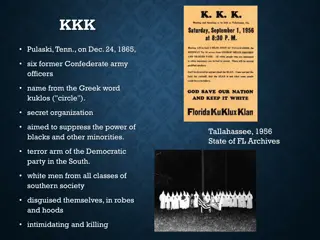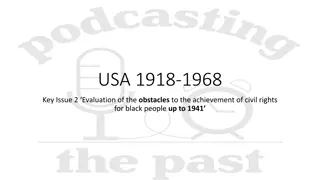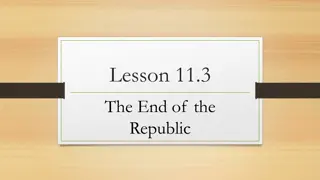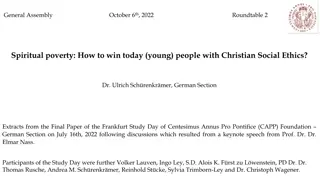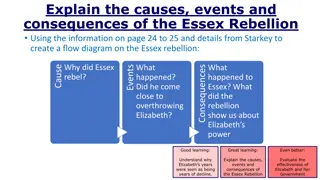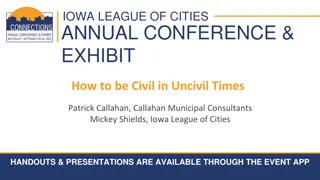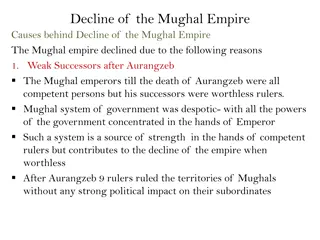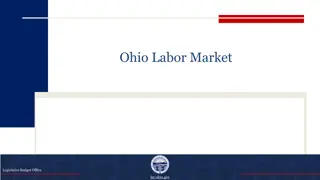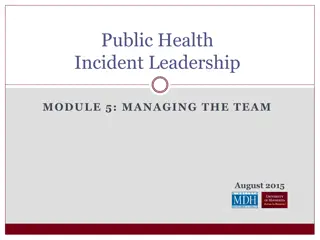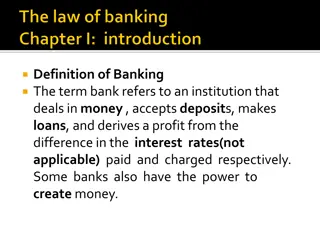The Rise of the KKK: Origins, Objectives, and Decline
The Ku Klux Klan (KKK) was founded in Pulaski, Tennessee, in 1865 as a social club for former Confederate soldiers. Over time, it evolved into a terrorist organization with the goal of discouraging black people from holding positions of power and enforcing segregation through fear and violence. Despite widespread violence, the Klan eventually declined in the late 1800s due to the Enforcement Acts passed by the US Congress. These acts protected the rights of African Americans and allowed federal intervention in states where needed.
Download Presentation

Please find below an Image/Link to download the presentation.
The content on the website is provided AS IS for your information and personal use only. It may not be sold, licensed, or shared on other websites without obtaining consent from the author. Download presentation by click this link. If you encounter any issues during the download, it is possible that the publisher has removed the file from their server.
E N D
Presentation Transcript
The Rise of The KKK Eric, Rebecca, Will, and Nate
The Original Klan The Klan was formed in Pulaski, Tennessee, in 1865. It was originally founded as a social club for former confederate soldiers. The group gained popularity and eventually became a terrorist organization.
Founding Members The Klan was set up by John Lester, Calvin Jones, Richard Reed, James Crowe, Frank McCord, and John Kennedy. These men were former confederate soldiers and citizens who agreed with their racist ideas. They wanted to create a club with rules closely related to the Kuklos Adelphon fraternity.
Objectives The goals of the Klan were to discourage black people from taking positions of power and authority, and to enforce segregation. They did let them to vote.
Strategies The Klan used fear and intimidation to control the lives of black people. They would break into their houses at night, whip them in the street at night, and they would dress in white robes to look like ghosts and scare people. The racist activities lead to riots targeting blacks and Republicans.
Violence Caused By The Klan Policemen assisted in a 1866 riot between whites and black ex-soldiers in Memphis, Tennessee. Leaving 46 people dead, 70 were injured, and numerous churches and schools burned down. On July 30th(two months later) a similar outbreak erupted in New Orleans when a white mob attacked the attendees of a black suffrage convention; killing 37 blacks and 3 whites who allied with them.
Government Response Police officers not only gave no protection to black citizens but joined the Klan members in crimes against them. Local government put adds in the paper to warn about the Klan.
Decline (late 1800s) The fall of the Klan was due to the Enforcement Acts. They were three bills passed by the United States Congress between 1870 and 1871. They were criminal codes which protected African-Americans right to vote, to hold office, to serve on juries, and receive equal protection of laws. The laws also allowed the federal government to intervene when states did not act. These acts were passed following the ratification of the Fourteenth Amendment to the US Constitution, which gave full citizenship to anyone born in the United States or freed slaves, and the Fifteenth Amendment, which banned racial discrimination in voting. The government banned the use of terror, force or bribery to prevent people from voting because of their race. Other laws banned the KKK entirely.
Rise (1920s) The rise was inspired by Thomas Dixon s 1905 book The Clansman and D.W. Griffith s 1915 film Birth of a Nation. The rise was fueled by growing hostility towards the increasing rate of immigration and the fear of communism after the Bolshevik revolution in Russia (1917). In 1915 white protestants organized a revival of the Ku Klux Klan outside of Atlanta, Georgia. William J. Simmons, set afire to a cross on top of Stone Mountain to represent the new organization.
Changes The new Klan targeted, in addition to black people, Roman Catholics, Jews, foreigners, and organized labor.
Followers At its peak in the 1920 s, Klan membership exceeded 4 million people nationwide.
Government Connection Calvin Coolidge was believed to be a member of the KKK but he was not actually. Coolidge s biography shows that his upbringing was not in support of racist ideas. He never supported the organization and always spoke out against racism and supported those targeted by the Klan. Suspicion of his involvement was due to his lack of emphasis on the issue. Some wish he would have spoken out more forcefully against racism. Hugo Black was a member of the KKK and a supreme court member.
Demise The Klan leader, David C. Stephenson, was convicted for second degree murder in the 1920 s. This caused a drop in membership from 4,000,000 to around 30,000. Eventually the KKK decreased so much that it was no longer an active threat.


